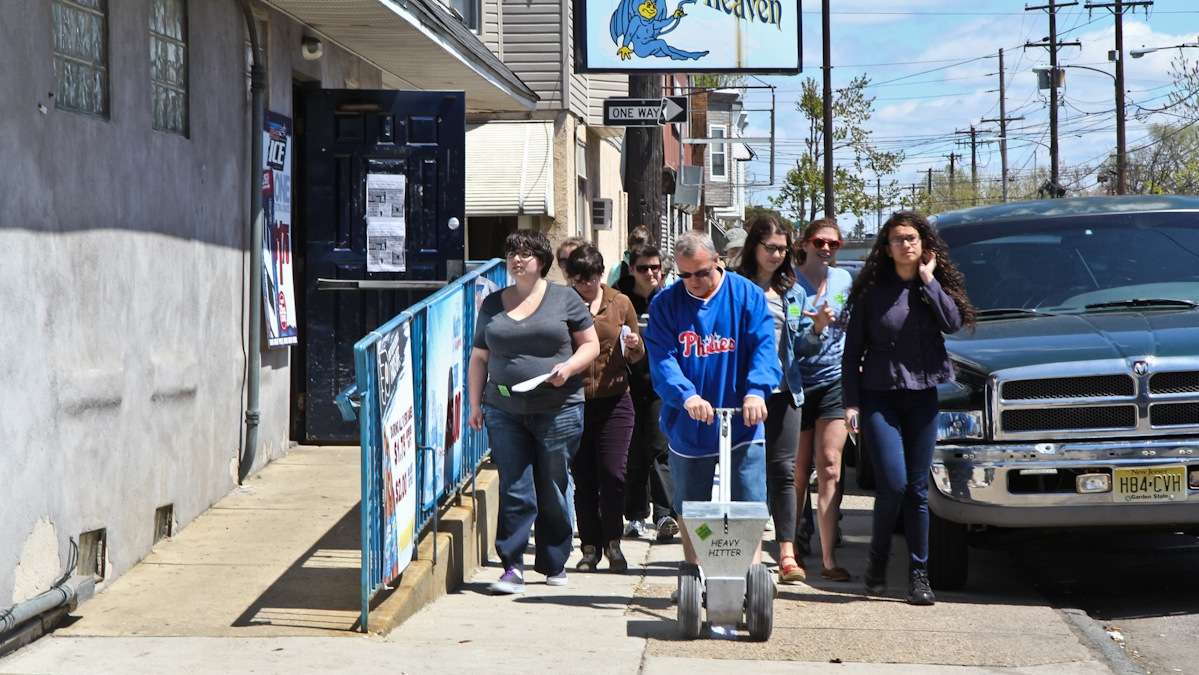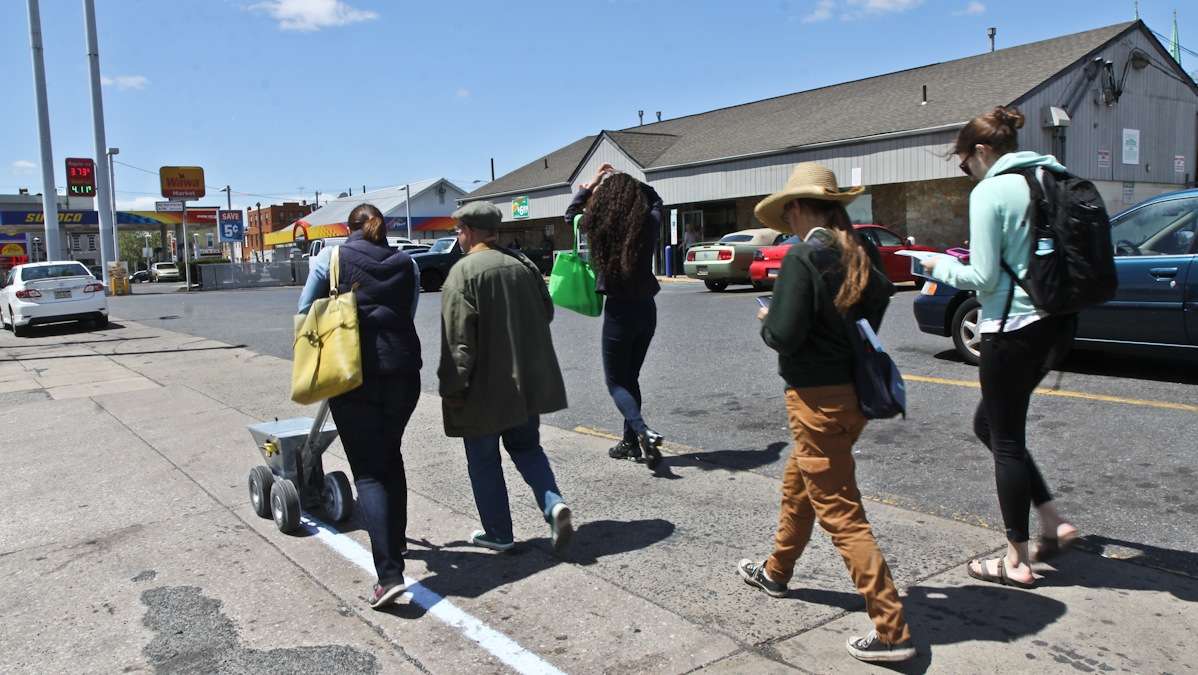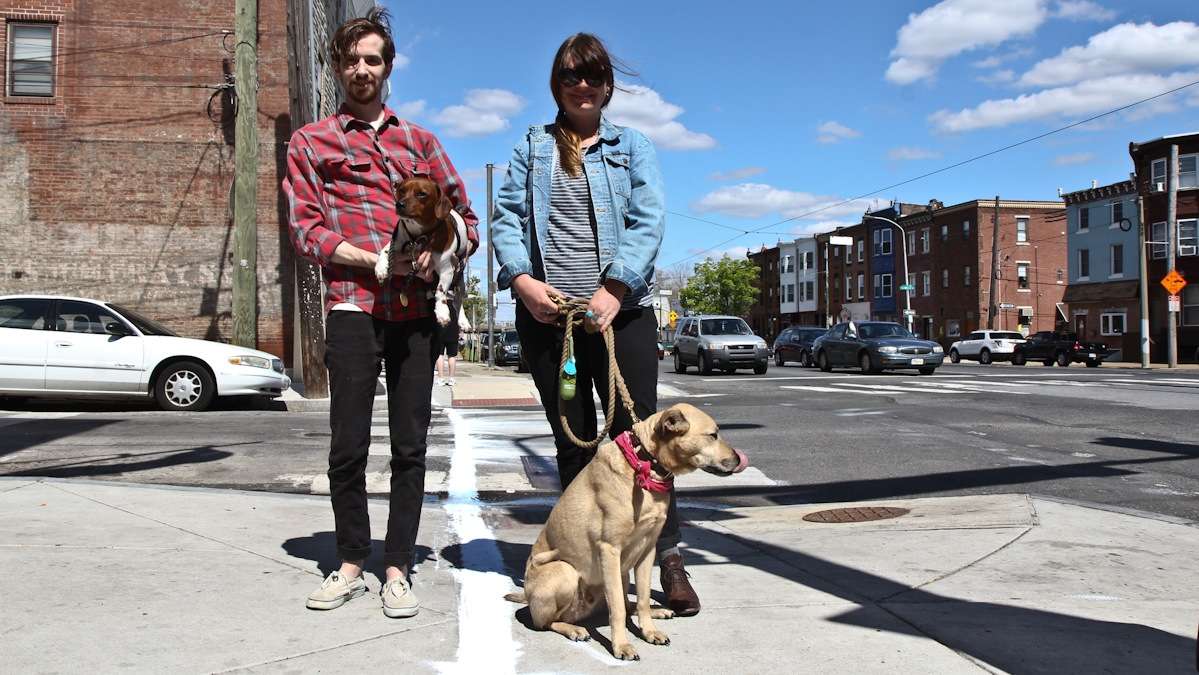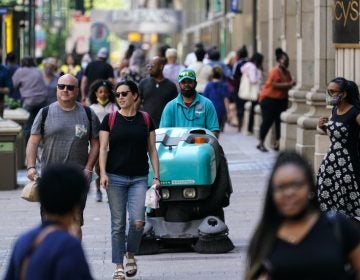Vividly illustrating climate change, artist draws a high water line in Philly neighborhoods
ListenIn Philadelphia, an artist is launching a down-to-earth means of starting conversations about climate change.
The third National Climate Assessment has pundits talking about what can — and should — be done to blunt the effects of climate change. Those strategy discussions are exactly what the White House hoped would happen following release of the report.
In Philadelphia, an artist is launching a much more down-to-earth means of starting conversations. She’s marking a chalk line through neighborhoods to show what areas would be flooded out by a 10-foot storm surge.
Despite the most detailed maps, charts and statistical projections about rising sea levels, it can remain theoretical.
For residents of Kensington, Fishtown and Port Richmond, seeing the thick chalk line dissecting four miles of sidewalks, parking lots, shopping centers and streets has made it up close and personal.
From his front door in Port Richmond, Richard Scheerer can see the train tracks that run close to the Delaware River about two blocks from the water. He can also see the new white line. Although he said he’s never thought about floods inundating his home, seeing the line has him a bit worried.
At the corner of Richmond and Anne streets, Eve Mosher described the reach of the river in the event of a 10-foot surge. The chalk line punctuated her points.
“We are standing right near I-95. We are inland from the railway tracks, so the water would come over the railroad tracks, flood under I-95 and flood the neighborhood here,” she said.
A call to action
The “HighWaterLine” project is about bringing awareness and inviting neighbors to take action, said Mosher. The Chemical Heritage Foundation in Philadelphia commissioned it as part of its “Sensing Change” art and science initiative on climate change.
To draw the thick powdery line, Mosher used the same kind of machine that marks the white lines on baseball diamonds. Following a map, she left a thick, powdery line in her wake, right at the edge of a 10-foot flood zone.
“The 10-foot flood zone is generally used by coastal communities to demarcate the 100-year flood zone,” Mosher explained. “But with climate change, it becomes a 40-year flood zone, a few years later it becomes the 20-year flood zone. When I did the project in 2007 [in New York City], the scenario was that, by 2100, it would become the four-year flood zone.”
Realizing there was scant attention to predictions about sea-level surge and flooding should a big storm hit New York City, Mosher began her first HighWaterLine project in 2007 in Brooklyn.
The project became eerily prophetic when Superstorm Sandy hit and water levels rose beyond her white line. “I didn’t want to be right,” she said.
Stakes are high in Philadelphia
Philadelphia’s 10-foot zone is a crowded place, she said.
“There’s a lot of factory and industry along the waterfront,” she said. “There’s a lot of Superfund sites along the waterfront. So we really need to consider how the water increase can impact that.”
This project reaches people in a way that scientific papers and news stories about climate change don’t, said Raluca Ellis, staff environmental scientist at the Franklin Institute and director of the Climate Urban Systems Partnership, a participant in the project.
“Having an artist here and showing physically how far the water could come into the neighborhood is very powerful,” Ellis said. “So this art piece is meant to get a conversation starting , to engage people with it, not to scare anyone.”
Reactions to the white line — and its portent — were mixed along Mosher’s route. Some were stoic, others brushed it off, one man said he would invest in a canoe.
Standing along the chalk line on East Somerset Street, a Kensington old-timer who preferred to be called Joe isn’t fazed.
“Since that river floods out, it’s going to come over here. Because we are what? Three blocks, two blocks away,” he said. “I don’t disagree with them, I just hope it doesn’t happen in my lifetime.”
A few blocks south on Girard Avenue, Dorothy D’Amico and a friend were seated at an outdoor table, enjoying a beer.
“So how long is that going to take?” she said. “If I’m not going to be here, I’m not going to be dead. I’m not going to worry about it.”
At every step of the way, Mosher made sure to bring attention to the work already in progress in Philadelphia to manage stormwater that is helping the earth absorb rain and involving industries and developers in devising solutions.
Though the rain eventually erased the line, Mosher said she wants the conversation keeps going.
That hit home for a man fixing his house near Delaware Avenue across from Pennypack Park.
After hearing from Mosher, he said he will look into “this flooding thing.”
“I had no idea,” he said. “It’s all news to me. I’ll find out more about it … it sparked my interest for sure.”
WHYY is your source for fact-based, in-depth journalism and information. As a nonprofit organization, we rely on financial support from readers like you. Please give today.









